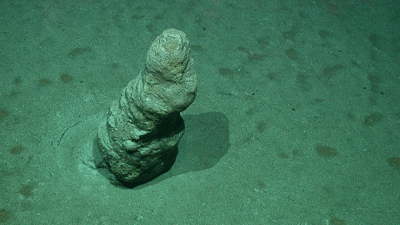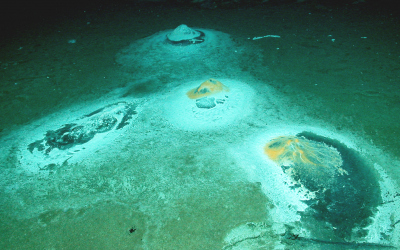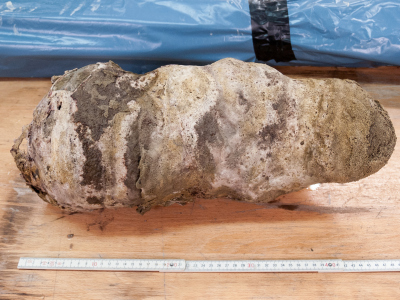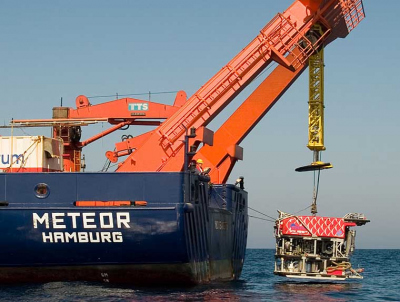Page path:
- Home
- Discover
- Media Releases
- Media Releases 2016
- Seep-carbonate lamination
Seep-carbonate lamination
In 2007, during a dive of the submersible vehicle MARUM-QUEST in 734 meters of water off the coast of Pakistan, MARUM scientists discovered a column protruding out of the sea floor. On METEOR Expedition M74/3, the vehicle was able to retrieve the column for detailed study in the laboratory. “The two QUEST pilots skillfully manipulated the arms of the submersible to free the unwieldy sample from the sea floor and fix it securely to the front working platform of the vehicle for the ascent back to the ship,” reports chief scientist of the cruise Gerhard Bohrmann. Analysis of the specimen, which is almost a half meter long with a diameter of 12 to 17 centimeters, revealed its composition to be limestone. This limestone column is not a relic from a sunken city but a product of microorganism activity. Special microorganisms that can utilize methane colonize sites where methane gas escapes from the sea floor. Hydrogen sulfide is formed with the conversion of methane from the sea floor and sulfate from the sea water, and calcium carbonate is deposited as a byproduct. Because this reaction can only occur in the absence of oxygen, or conditions of very sparse oxygen, this kind of limestone is rarely formed, and it usually occurs within the sea floor. “Because this limestone cannot form in oxygenated sea water, it literally grows downward into the oxygen-free sediment,” explains Dr. Tobias Himmler of MARUM. “It was possible, however, for this limestone column to grow upward into the water column because there is hardly any oxygen present at a depth of 734 meters in this area of the northern Arabian Sea.” Even though such oxygen minimum zones are relatively common worldwide, column-shaped limestone structures like this one are rarely found on the sea floor.
A cut along the length of the column reveals a distinctive feature: it is made up of thin layers that are less than a millimeter thick. Tobias Himmler studied the finely laminated column and counted a total of 204 layers. The base of the column was formed around 1,130 years ago. Microtomographic analyses show that the structure remained sufficiently permeable for methane gas to continue to migrate through the column from the site of its release in the sea floor up to the microorganisms.
Further investigations suggested to the geologists that recurring sediment input contributes to the layering. The sediment particles remain on microbial mats on the top of the limestone column. As Himmler explains, “The layering develops primarily due to the Indian monsoon, which regulates particle flux in the Arabian Sea on a seasonal scale.” An atmospheric process thus influences carbonate deposition at methane seeps on the bottom of the Arabian Sea in hundreds of meters of water. According to Himmler and his co-authors, the limestone column represents a climate archive in this monsoon region that so far has not been studied.
Publication:
Tobias Himmler, Germain Bayon, David Wangner, Frieder Enzmann, Jörn Peckmann & Gerhard Bohrmann
Seep-carbonate lamination controlled by cyclic particle flux
Published in Scientific Reports, doi: 10.1038/srep37439
A cut along the length of the column reveals a distinctive feature: it is made up of thin layers that are less than a millimeter thick. Tobias Himmler studied the finely laminated column and counted a total of 204 layers. The base of the column was formed around 1,130 years ago. Microtomographic analyses show that the structure remained sufficiently permeable for methane gas to continue to migrate through the column from the site of its release in the sea floor up to the microorganisms.
Further investigations suggested to the geologists that recurring sediment input contributes to the layering. The sediment particles remain on microbial mats on the top of the limestone column. As Himmler explains, “The layering develops primarily due to the Indian monsoon, which regulates particle flux in the Arabian Sea on a seasonal scale.” An atmospheric process thus influences carbonate deposition at methane seeps on the bottom of the Arabian Sea in hundreds of meters of water. According to Himmler and his co-authors, the limestone column represents a climate archive in this monsoon region that so far has not been studied.
Publication:
Tobias Himmler, Germain Bayon, David Wangner, Frieder Enzmann, Jörn Peckmann & Gerhard Bohrmann
Seep-carbonate lamination controlled by cyclic particle flux
Published in Scientific Reports, doi: 10.1038/srep37439
Bacterial mats in the Arabian Sea colonize methane seep sites at 730 meters, leading to the formation of limestone columns.
Photo: MARUM, University of Bremen
Salvaged limestone column in a laboratory on board the research vessel METEOR.
Photo: MARUM, University of Bremen; V. Diekamp
Deployment of the submersible vehicle MARUM-QUEST from the research vessel METEOR during Expedition M74/3 in the Arabian Sea.
Photo: MARUM, University of Bremen; V. Diekamp
Underwater videos from the Arabian Sea
Weitere Informationen / Bildmaterial:
Jana Stone
MARUM-Öffentlichkeitsarbeit
Telefon: 0421 218 65541
E-Mail: [Bitte aktivieren Sie Javascript]
Jana Stone
MARUM-Öffentlichkeitsarbeit
Telefon: 0421 218 65541
E-Mail: [Bitte aktivieren Sie Javascript]






